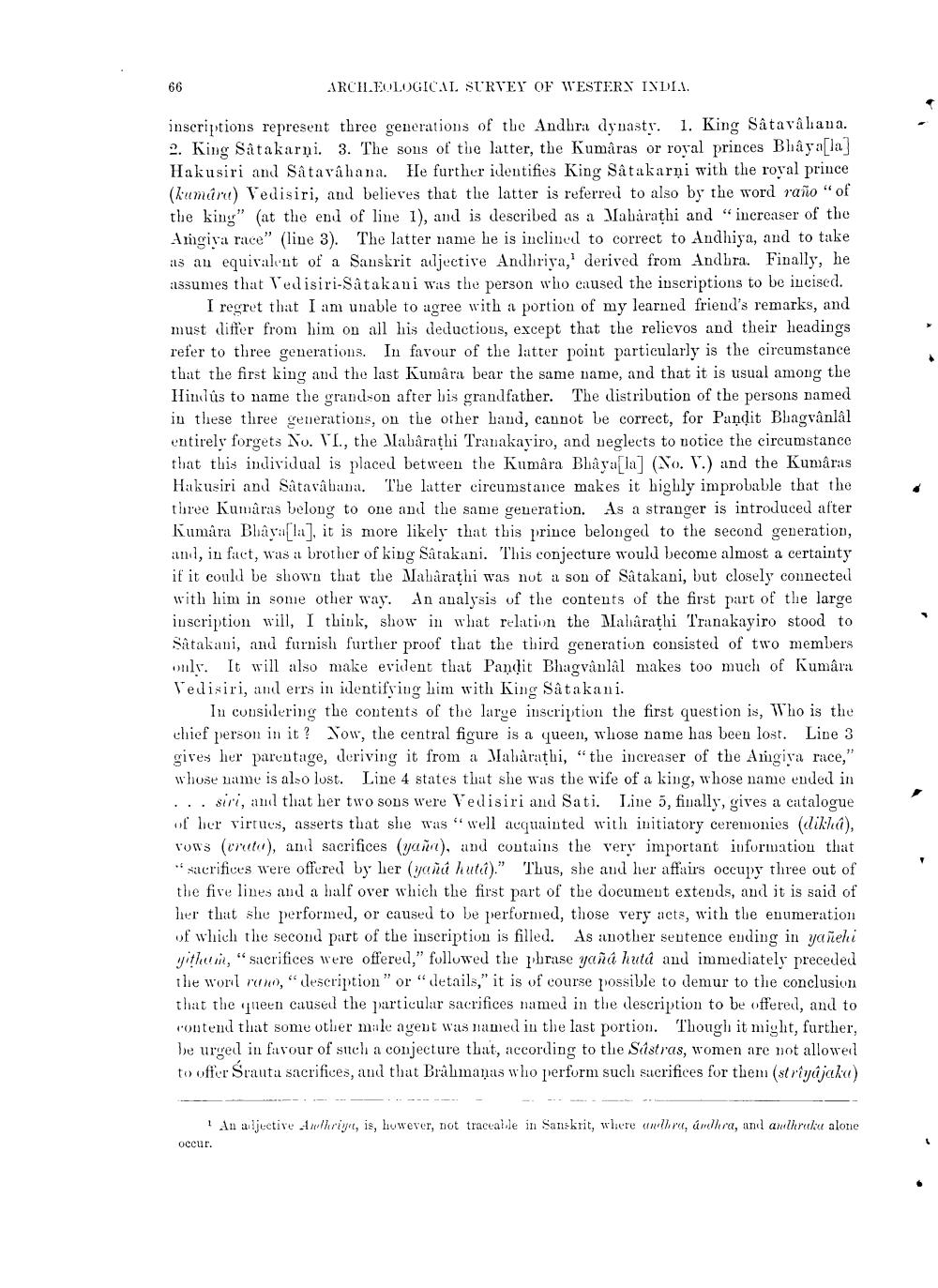________________
ARCHEOLOGICAL SURVEY OF WESTERN INDI..
inscriptions represent three generations of the Andhra dynasty. 1. King Satavahana. 2. King Så takarni. 3. The sons of the latter, the Kumâras or royal princes Blâya[la] Hakusiri and Satavahana. He further identifies King Satakarņi with the royal prince (kumare) Vedisiri, and believes that the latter is referred to also by the word raño "of the king" (at the end of line 1), and is described as a Mabarathi and "increaser of the Angiva race" (line 3). The latter name he is inclined to correct to Andhiya, and to take its an equivalent of a Sanskrit adjective Andhriya,' derived from Andhra. Finally, he 13sumes that Vedisiri-Satakani was the person who caused the inscriptions to be incised.
I regret that I am unable to agree with a portion of my learned friend's remarks, and must differ from him on all his deductious, except that the relievos and their headings refer to three generations. In favour of the latter point particularly is the circumstance that the first king and the last Kumâra bear the same name, and that it is usual among the Hindús to name the grandson after his grandfather. The distribution of the persons named in these three generations, on the other hand, cannot be correct, for Pandit Bhagvânlal entirely forgets No. VI., the Mabarathi Tranakayiro, and neglects to notice the circumstance that this individual is placed between the Kumâra Blâya[la] (No. V.) and the Kumâras Hakusiri and Såta vâ hana. The latter circumstance makes it highly improbable that the three Kumâras belong to one and the same generation. As a stranger is introduced after Kumara Bhaya[la], it is more likely that this prince belonged to the second generation, and, in fact, was a brother of king Sârakani. This conjecture would become almost a certainty if it could be shown that the Maharathi was not a son of Satakani, but closely connected with him in some other way. An analysis of the contents of the first part of the large inscription will, I think, show in what relation the Mabarathi Tranakayiro stood to Satakani, and furnish further proof that the third generation consisted of two members only. It will also make evident that Pandit Bhagvânlal makes too much of Kumara Vedisiri, and errs in identifying him with King Satakani.
In considering the contents of the large inscription the first question is, Who is the chief person in it? Now, the central figure is a queen, whose name has been lost. Live 3 gives her parentage, deriving it from a Mabarathi, "the increaser of the Argiva race," whose name is also lost. Line 4 states that she was the wife of a king, whose name ended in ... siri, and that her two sons were Vedisiri and Sati. Line 5, finally, gives a catalogue of her virtues, asserts that she was "well acquainted with initiatory ceremonies (dikla), Vows (cratur), and sacrifices (yann), and contains the very important information that * sacrifices were offered by her (yañå hutit)." Thus, she and her affairs occupy three out of the five lines and a half over which the first part of the document estends, and it is said of her that she performed, or caused to be performed, those very acts, with the enumeration of which the second part of the inscription is filled. As another sentence ending in yawehi yithun," sacrifices were offered," followed the phrase yañá hutd and immediately preceded the worl runn,"description" or "details," it is of course possible to demur to the conclusion that the queen caused the particular sacrifices named in the description to be offered, and to contend that some other male agent was named in the last portion. Though it might, further, be urred in favour of such a conjecture that, according to the Sastras, women are not alloweil to offer Srauta sacrifices, and that Brahmanas who perform such sucrifices for them (striyâjaka)
In a djective whriy, is, however, not tracvalle in Sanskrit, where anillera, úmihra, and anthraku alone
occur.




